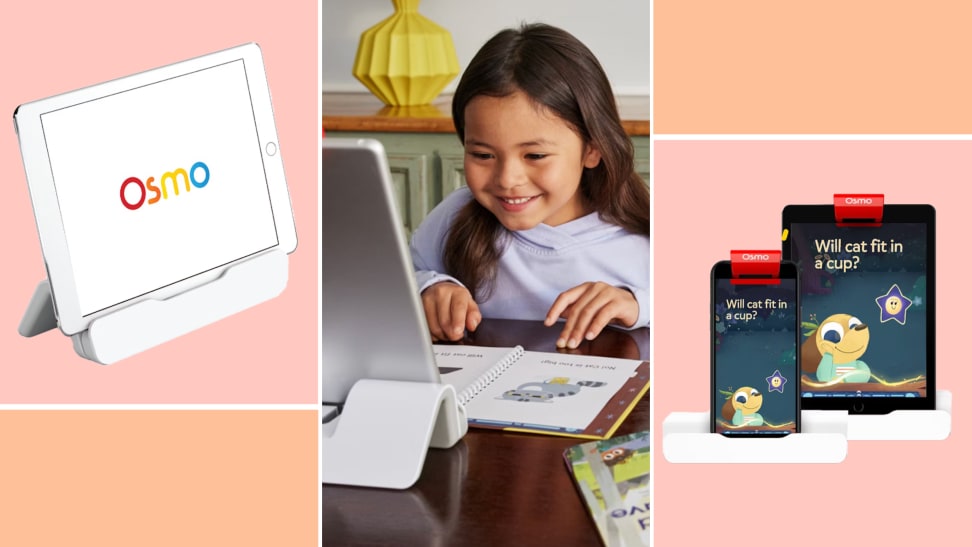 Credit:
Reviewed / Osmo
Credit:
Reviewed / Osmo
Recommendations are independently chosen by Reviewed's editors. Purchases made through the links below may earn us and our publishing partners a commission. Prices were accurate at the time this article was published but may change over time.
-

Osmo Reading Kit
Pros
-
Easy to use
-
Video game quality
-
Great value
-
Effective teacher
Cons
-
Could be more challenging
-
Recognition capabilities could improve
-
Kids love tablets. It’s pretty much a universal fact at this point. But, figuring out what your house rules are about said tablet can be a lot of work. Is YouTube acceptable? If so, what channels? And what games are at worst inoffensive and at best educational?
Osmo, the maker of hands-on learning games from Toronto-based company Tangible Play, Inc., is aimed at taking a little of the guesswork out of that whole process. Osmo’s iPad or iPhone-mounted system is aimed, the company says, at helping “children interact with technology without losing the value of hands-on play.”
But what in the world is Osmo (available at Osmo) , and how does it work? What’s good about it, and what left us wanting more?
We tested out two of Osmo’s most popular sellers—the “Reading Adventure” subscription box and the Disney Magic Workbook bundle—on our own set of twin 5-year-olds. They were just starting to figure out how to read when we started working with the Osmo, but overall it seems like this system helped give them the phonics-based push they needed to start sounding out words on their own.
Here’s how that happened.
About Osmo
- Base: iPad, Fire
- Compatible devices: Apple iPads with iOS 15 and up (excluding iPad (Gen 1–4), iPad Mini 1–3 and iPad Air 1) and compatibility coming later in 2023 for iPad 10th Gen, iPad Pro 11” (4th Gen), and iPad Pro 12.9” (6th Gen); Fire tablets with Fire OS 7 and up, including Fire HD 8 (8th, 10th & 12th Gen), Fire HD 10 (9th & 11th Gen) and compatibility coming later in 2023 for Fire 7 (2022) and Fire 8 (2022); Apple iPhones with iOS version 11 and up (for Coding games, Genius Words, Numbers, Tangram, and Disney BYJU’s Learning Workbooks only), including iPhone 12, iPhone 12 Pro, iPhone 12 Pro Max, iPhone 13, iPhone 13 Pro, iPhone 13 Pro Max, iPhone 14, iPhone 14 Plus
What is Osmo and how does it work?
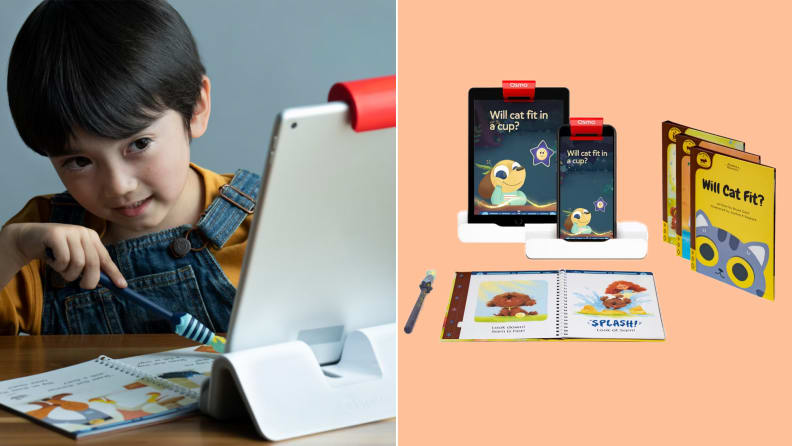
Osmo offers a comprehensive reading kit that uses a tablet to teach kids an array subjects including reading, coding, mathematics and more.
In essence, the Osmo system is really three things:
- An iPad or iPhone stand with a reflecting mirror that goes over the device’s camera
- An accompanying subscription to the company’s online assets
- Tactile items that come with whatever Osmo game or starter set you choose
For “Reading Adventure,” the stand and mirror came with four camera-ready books for beginning readers and a little wand that the kids could use to point to words on the page, wiggle at the screen for games, or just play around with when they needed something to fidget with.
It was a similar story for the Disney Magic Workbook bundle, which came with actual workbooks and pens.
However, if you pick out something else—Osmo’s Little Genius starter kit or a Coding set, for instance—your box would be full of other manipulatives and items that would work with the accompanying Osmo games.
Like so many things with kids, Osmo is fairly easy to use. Snapping the iPad into the stand and throwing the mirror on the camera takes about two seconds, and then all you have to do is sign up for the program online using the code that comes in your box.
There’s no charge to play the accompanying Osmo games, which is nice. Once you’ve bought your Osmo box, you’ll own that game for life, subscription fees be damned, and once you’ve created an account it’s easy to hop back and forth between users and games.
Once you’re all signed up, the on-screen game will pretty much guide you (or, really, your kid) about what’s next.
For Reading Adventure that meant that I had to indicate where I thought my kids’ level of reading knowledge was. Could they discern letters? Did they know the sounds of those letters? I chose yes, but for whatever reason the Osmo still sort of started in that realm with them, perhaps just so they’d get used to the system.
The Osmo system can actually recognize your child’s voice (sort of, but more on that later) so it can hear, for instance, if your kid says “buh” when it shows a “B” and asks what sound it makes.
Once your kid gets all those games down, it’ll ask them to slide one of the accompanying books or workbooks up under the screen, where it will use the mirror to recognize the book, what page the child is on, and then go from there.
For Reading Adventure, we started with a book called “Will Cat Sit,” which it then read to us, while making sure we turned the pages at appropriate times.
My kids got a sense of what words looked like, where they were, and how they all fit together. They then played a few games that were in the back of the book—some reading comprehension questions and some “use the wand to point at the right letter” type stuff—and then they moved on to the next book.
It’s worth pointing out here that the whole time in Reading Adventure, at least, there’s a sort of video game quality to the action on-screen. You’re on a quest with a little dog buddy to capture these fairy-like dream creations, and you can only do that by completing challenges, whether on-screen or on the page. Along the way the kids are learning all new phonics lessons, but it’s all couched under the “collect ‘em all” mentality that’s inside at least that game. (The Disney box doesn’t really have that, so much, which is why I liked it less, but, again, more on that later.)
Your kids can use the Osmo for as much time or as little time as you think is fair. My smart, almost-reading kids used it for about an hour each for a couple of days, though, and all of the sudden they were reading the books on their own.
I questioned whether they had just learned the books—they’re good like that sometimes—but when the Osmo would throw new words at them and ask them to sound them out, they were pretty good at it. When I picked up some new Level 1 reader books at the library on the way home as a test of my own, they were able to read about 70% of the way through those, too.
What I liked about Osmo
Osmo taught my kids to read
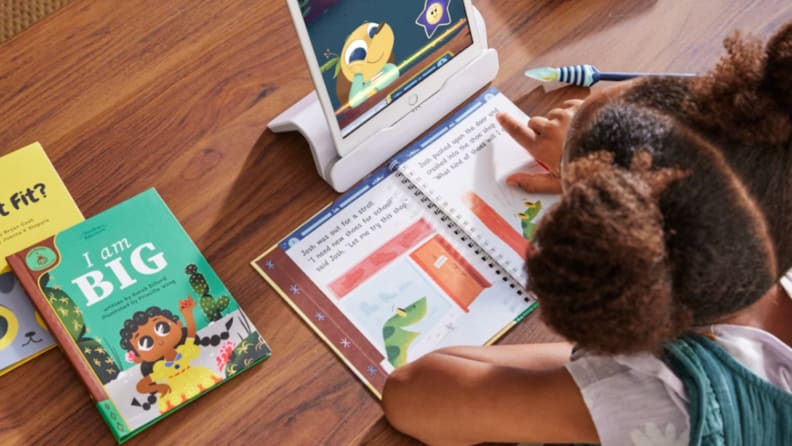
Parents can rest assured at the fact that Osmo's targeted reading lessons actually work.
I liked that Osmo taught my kids to read—or at least how to synthesize all the lessons that my husband and I, and their teacher, had drilled into them.
Let me be frank: As a parent, I don’t always know how to teach my kids to do something. Sure, they should know how to ride a bike, but how do you actually teach that? The same thing goes for swimming or for navigating the tangled world of online videos.
These teachable moments can seem like huge mountains that we don’t have the first clue about climbing, so having Osmo games to help guide the way and light the path was really helpful.
Osmo is easy to use for both kids and parents
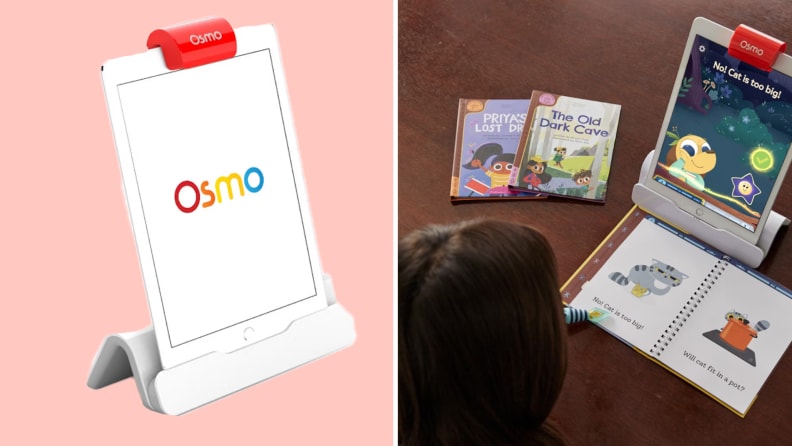
If your kiddo loves tablet time for their gaming quests and interactive activities, they won't have a hard time navigating Osmo's platform.
In my house, we already have an iPad that we use to talk to Grandma and Grandpa, so we didn’t need a whole lot of gear or product to get up and running with the Osmo system.
The books and the wand are also pretty cute, so my kids liked looking at and playing with them.
I also liked that I could be as involved as I wanted or needed to be at any given time. Sometimes, I wanted to sit with my kids and watch them figure a game out or sound out letters and words.
Other times I let them sit by themselves and use the Osmo while I made dinner or, frankly, just had my own little dose of screen time.
I never thought what was on-screen was boring or irksome when I did sit with them, which isn’t always the case with kids’ games, and I liked watching the gears in their heads turn as they figured everything out.
It’s affordable and offers great value
While Osmo isn’t bargain-basement cheap, it’s relatively inexpensive. Reading Adventure costs just $40 and includes both the starter kit and four books. If you decide to keep the subscription going you’ll get four more books every month, also for $40 per month. At just $10 a book, that’s pretty much what you’d pay in the store if you were buying something for your kid—except this one also has the added bonus of the online component.
While the Disney set is more expensive, retailing for about $159, it comes with eight different workbooks, in a variety of subjects. I can see it being really helpful for someone who’s homeschooling their kids or who might want to get their little one set up for kindergarten.
What I didn't like about the Osmo
You can only connect to one Apple ID
You will have to connect your Osmo account with one specific Apple ID, meaning that if you need to make a change or want to activate a new box (like a Disney Magic Box after you’ve already played with a Reading Adventure box, let’s say), you’ll need the account holder to be there to put in their password and present their fingerprint.
It could be more challenging
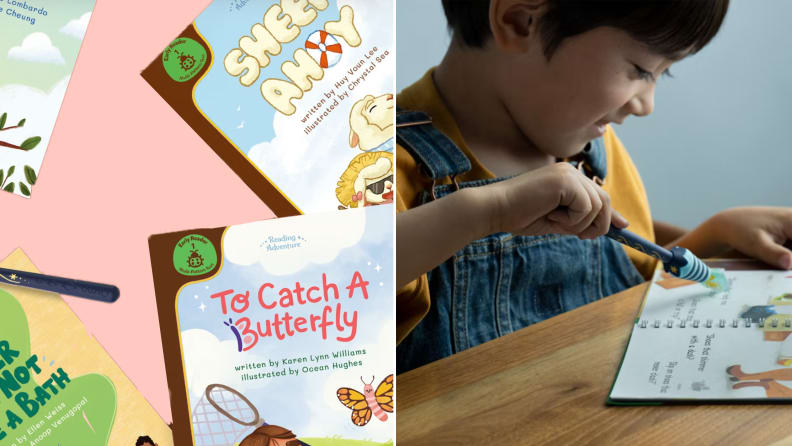
Although the Osmo site allows you to personalize your child's reading experience through skill level selection, this was no longer suitable after a few lessons.
As I mentioned above, I also thought that occasionally the Osmo presented lessons that I felt were a bit below where my kids were, learning-wise.
This happened at the beginning of us using the Reading Adventure set, where I eventually just skipped forward through a few lessons, and with the Disney Magic box, which it said was for first graders, but which opened with a lesson about identifying colors—something my kids have known for years. If I hadn’t stepped in and skipped through a whole bunch of stuff, particularly with the Disney kit, I think they would have lost interest in the whole thing very quickly.
The Osmo’s recognition capabilities need work
When you start using Osmo, it will tell you that it won’t always correct your child. The software is more interested in how the child is doing overall and it allows your child to make mistakes, as would any teacher.
This philosophy is great, but I watched my son tearing through lessons about reading three-letter words where he was only adjacent to what they were actually supposed to be. “Sun” instead of “sit,” let’s say, or “Pup” instead of “Pig.”
My son being a little wiley, he didn’t really care if he was getting anything right or wrong, he just wanted to play the game. As a mom though, I was a little taken aback. Was he really learning to read these words if he wasn’t getting them right? And shouldn’t the Osmo at least have corrected him a little?
I made him slow down and we tackled the words together, but if I hadn’t been in the room or watching, I really would never have known.
What Osmo game or package should you order?
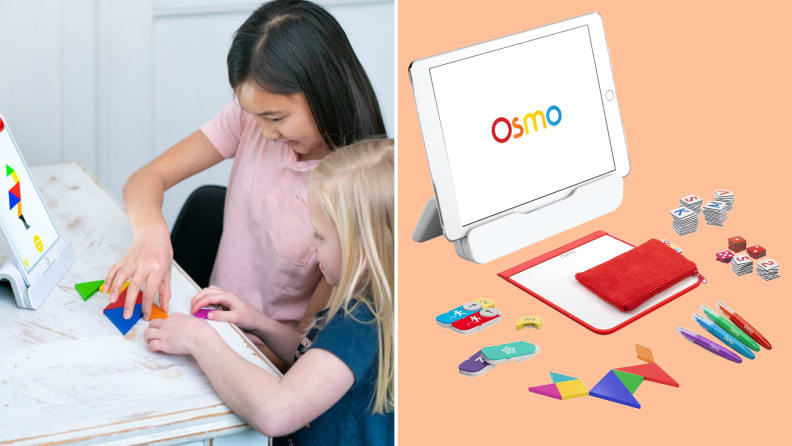
Osmo's packages include a variety of challenges and skill levels for multiple age ranges, so your child won't feel limited.
There really are so many Osmo games and packages, so choosing one can be tough. Think about what your individual kid is focusing on, whether it’s math, art, reading, or general studies.
If you think they might want to learn to code, check out the coding kit. If they’re going into first grade and just need a boost, there’s a first grade system that might make their learning a little more fun than whatever’s going on in the classroom.
Personally, I think anyone who’s new to the system should start with something simple, like Reading Adventure, which you can adapt to any sort of beginning or early reading level.
The Genius Starter Kit also seems like a great place to begin for slightly older kids ages 6 through 10, since it covers all sorts of STEAM related topics.
If you’re looking for something more general, there’s also the Explorer Starter Kit, which is great for ages 5 to 10.
Is Osmo worth it?
Yes, especially if your child needs a boost or wants to stay fresh over a school break
If you think that your child could use help mastering a certain academic skill—or if you could use some help with the instruction thereof, the Osmo can be a handy way to kickstart the process.
I really loved the time I spent with the one my family tested, and I’ve already recommended the Reading Adventures set to a few other parents at my kids’ preschool.
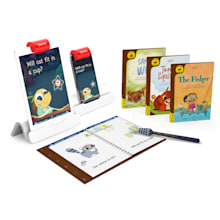
Now reading can remain fun during the summer season and other school breaks with the help of a tablet and Osmo’s academic kits.
Buy now at Osmo





